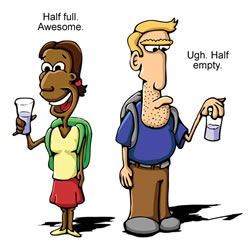Difference between Half Full and Half Empty
Key Difference: Half full and half empty refers to one’s perspective towards reality. Half full is the interpretation of reality in a positive context, whereas half empty is associated with the interpretation of reality in a negative context.
'Half full' and 'half empty' terms are used in context to a very popular phrase related to a glass. It refers to the glass with a liquid. The liquid covers half of the glass. Now, it depends upon the perspective of a person to refer this glass as half empty or half full. Just imagine you go to a restaurant, and asks for a drink. The waiter brings a glass and you can see the drink covers half your glass. Now, if you are asked about the quantity of drink. You might answer- half the glass is filled with the drink or half the glass is empty. Both are correct and referring to the same thing.

However, psychologically and philosophically, there is a vast difference between half full and half empty. Hall full phase is associated with an optimistic person as it depicts that the person is concentrating on the things he has and not on the things that are missing. On the other hand, half empty is associated with pessimists; people who only focus on things that are missing but not on the things that they already have. Due to the analogy, the phrases containing ‘half full’ and ‘half empty’ have become very popular and are used in various scenarios. Generally, half full depicts a positive attitude, whereas half empty depicts a negative attitude.
A person who look at things with a 'half full' attitude is able to keep himself happy than a person who view things with a ‘half empty’ attitude. The key word to describe the difference between them is ‘perspective’. Perspective is like a glass on the eyes. The things in reality remain the same but due to the glass being fitted on the eyes, one tends to see things differently. A red colored glass will make any thing look red colored, whereas a green colored glass will make that thing look green.
“We can complain because rose bushes have thorns, or rejoice because thorn bushes have roses.”

― Abraham Lincoln
These words are perfect to define the perspective and also to describe ‘half full and half empty’. A half full attitude always make you feel happy, whereas a half empty attitude will always make you sad.
We cannot control every single phenomenon related to our or another’s life. However, at least we can change the way to look at them. We can see the bright, positive and happy side of a situation or a thing rather than seeing the negative and depressing characteristics associated with any scenario or a thing. Some of these examples might help you in using these terms:-
- She will soon come out this difficult time, as she always sees her glass as half full.
- I see the glass half-full, so I always feel good.
- The glass is always half empty for pessimists.
- Do You See the Glass as Half Full or Half Empty?
Now, you can decide for your glass- Is it half full or half empty?
Image Courtesy: fatenglishman.com, babypips.com









Comments
Jonas Karlsson
Mon, 10/02/2017 - 20:32
Add new comment